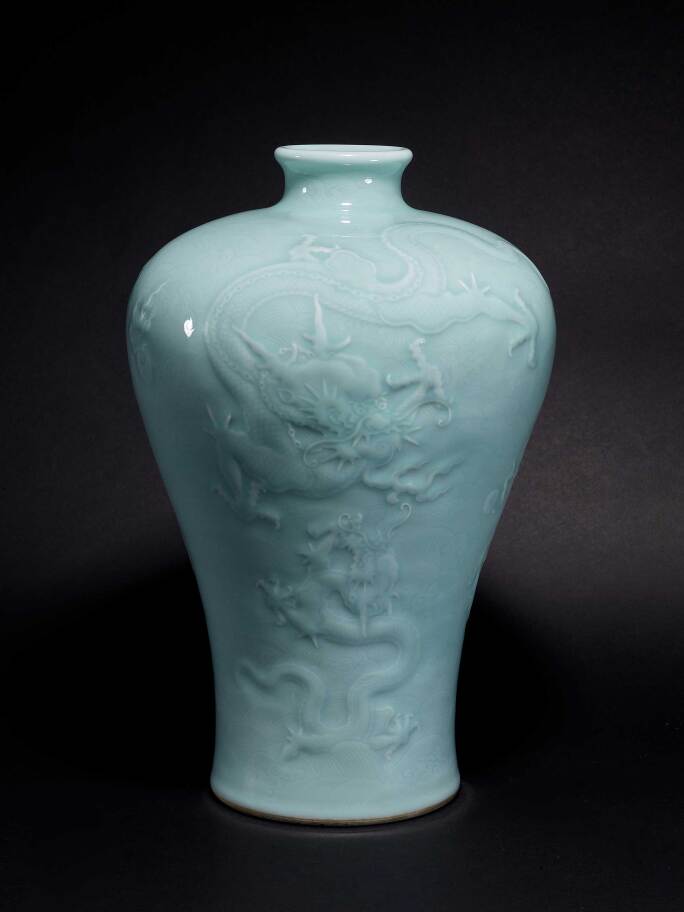
SEAL MARK AND PERIOD OF QIANLONG
With its harmonious yet striking combination of form, glaze colour, motif, and carving technique, the magnificence of this vase can hardly be overstated. Covered with an elegant celadon glaze, modelled with outstanding proportions and superbly carved with ferocious dragons against waves, the vase serves as a testament to the period of aesthetic achievement and technological mastery in porcelain production when Tang Ying (1682-1756) was supervisor of the imperial kilns in Jingdezhen. Tang’s exposure to the imperial art collection during his youth enabled him to study celebrated masterpieces from the past and adapt them to the contemporaneous tastes of the Yongzheng (1723-1735) and Qianlong (1736-1795) Emperors under whom he worked. The current vase, which is a particularly exemplary piece, is typical of wares made during this most celebrated period at the late Yongzheng to early Qianlong period.Ceramics with celadon glazes have always been held in high esteem from as early as the beginning of their production almost four thousand years ago, and in the Song dynasty alone, there was evidence of a continuation of imperial taste and style from the Northern (960-1127) to the Southern Song (1127-1279) dynasties, culminating in a superb clear bluish-green tone achieved on some of the finest wares from the Longquan kilns in the Southern Song dynasty. Despite this longstanding admiration of the celadon colour, the pure reduction firing technique required to achieve the said watery blue-green tone – perhaps due to its difficulty – appears to have been lost in the Yuan and Ming dynasties, and it was not until the Yongzheng period in the Qing dynasty that it was revived and employed on smaller pieces – albeit very rarely coupled with relief decoration. The inspiration of the style of decoration on the current vase may have been derived from a Yongzheng period celadon-glazed basin carved in relief, illustrated in Zhou Lili, Collection from the Shanghai Museum: Qing Dynasty Imperial Porcelain from the Yongzheng to Xuantong Period, Shanghai, 2014, pl. 3-32 (fig. 1). The seemingly soft bluish-green glaze on the current vase, however, is far from muted; evenly veiled over the exaggerated proportions of the vase upon which dragons are crisply carved and waves incised, the lustrous celadon glaze has thinned and pooled on the raised designs and recesses, creating tonal nuances in the glaze colour.
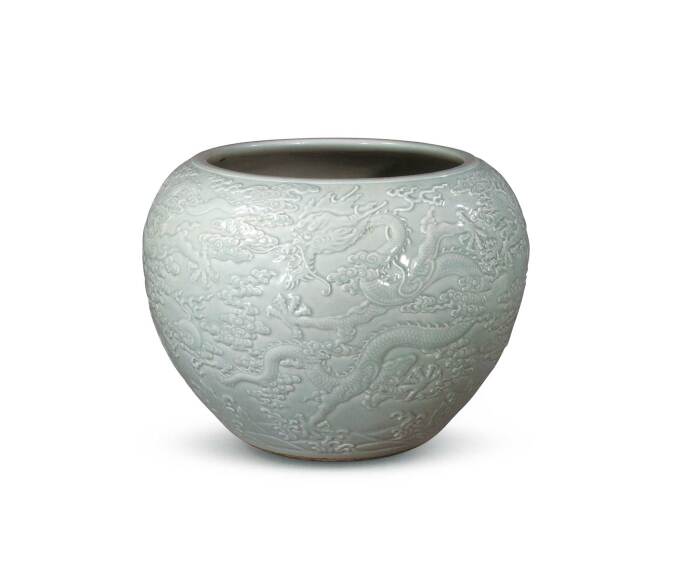
Celadon-glazed 'dragon' basin, Qing dynasty, Yongzheng period
© Shanghai Museum
The large and dramatic silhouette of the vase, marked by its heavily lipped rim atop the distinctly broad and prominent shoulders, a tapering waist, and a subtly splayed foot, on the one hand, demonstrates the painstaking precision and careful calculation in every stage of its production to avoid any irregularity, reminiscent of elegant Longquan celadon meiping from the early Ming dynasty, such as one in the Tokyo National Museum, formerly in the Yokogawa collection, published in the Illustrated Catalogue of Tokyo National Museum. Chinese Ceramics, vol. 2, Tokyo, 1990, pl. 486. On the other hand, it evokes the forceful relief-decoration of Longquan ‘dragon’ jars of the Yuan, such as the tall vessel in the Yamato Bunkakan, Nara, illustrated in Mikami Tsugio, Sekai tōji zenshū/Ceramic Art of the World, vol. 13: Ryō, Kin, Gen/Liao, Chin and Yüan Dynasties, Tokyo, 1981, pl. 156 (fig. 2).

Longquan celadon 'dragon' handled jar, Yuan dynasty
After: Mikami Tsugio, Sekai tōji zenshū/Ceramic Art of the World, vol. 13: Ryō, Kin, Gen/Liao, Chin and Yüan Dynasties, Tokyo, 1981, pl. 156
In addition to harking back to Longquan wares of earlier dynasties, decorative inspiration for the current vase may have come from a type of meiping from the Yongle period, of which close copies were made in the Yongzheng period, decorated with dragons reserved in white against a dense copper-red ground of crashing waves, such as one in the Palace Museum, Beijing, illustrated in Geng Baochang, Ming Qing ciqi jianding [Connoisseurship of Ming and Qing Porcelains], Hong Kong, 1993, fig. 26C.
Although dragons soaring amongst clouds and waves in pursuit of flaming pearls have been heavily employed as a motif on carved ceramic vessels and form part of the general repertoire of Chinese works of art, there is no question that the present representation of this glorified mythical beast is far superior to its common depiction, in terms of the remarkable quality of the carving and illusion of spatiality, as well as its compositional arrangement and subtle incorporation of archaistic elements.
The current vase is impressively carved in relief with five dragons, of which one is portrayed sinuous and extending vertically along one side of the vessel, and two pairs are depicted with one dominating and the other slightly subordinate, a motif that was not seen before the Qing dynasty as they were hitherto arranged symmetrically or rendered on a par with each other. One large three-clawed dragon, in particular, with its serpentine body writhing across the shoulder of the vase, is rendered swooping down towards a smaller five-clawed beast emerging from the crashing waves, with a flaming pearl in its mouth – a rare design exemplifying the creativity of the craftsmen under Tang Ying’s supervision. Such depictions of pairs of dragons are likely to refer to the Emperor and the Heir Apparent, though it has also been suggested that the depiction of large dragons with three claws and small ones with five may be an act of filial piety and a reflection of the Qianlong Emperor’s respect towards his father, the late Yongzheng Emperor.
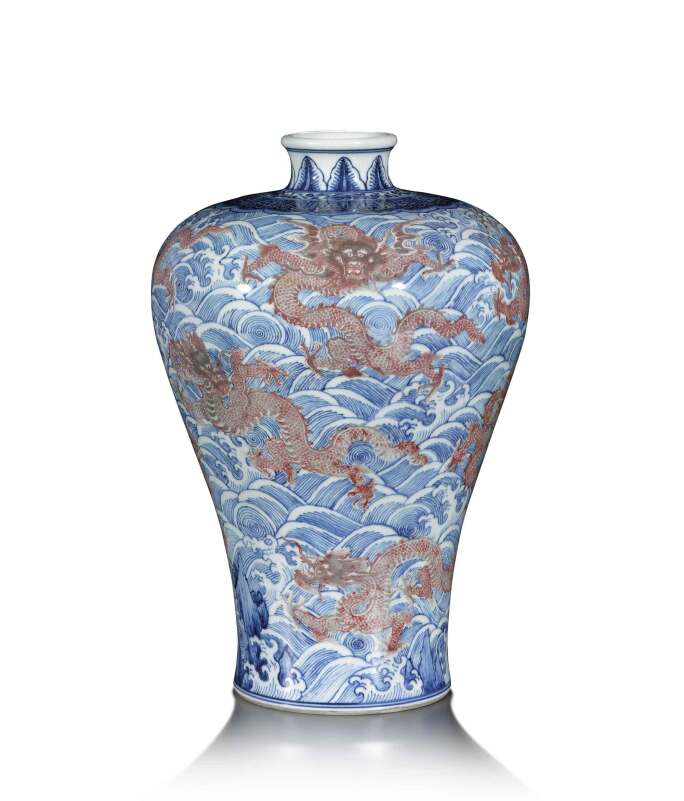
Cobalt-blue and copper-red 'nine dragon' meiping, Qing dynasty, Qianlong period
Sotheby's Hong Kong, 7th May 2002, lot 579
The use of three-clawed dragons also points at the infusion of elements reminiscent of those found on earlier ceramic wares, such as a slightly smaller Yuan dynasty blue-ground meiping (33.6 cm) reverse-decorated with a three-clawed dragon accentuated with raised slip, from the collection of Ernest Grandidier, now preserved in the Musée Guimet, Paris, inventory no. G121; and a Longquan celadon charger with an applied three-clawed dragon in biscuit, dated to the early to mid 14th century of the Yuan dynasty, illustrated in Regina Krahl, Chinese Ceramics In The Topkapi Saray Museum Istanbul. A Complete Catalogue. I. Historical Introductions. Yuan and Ming Dynasty Celadon Wares, London, 1986, pl. 109.
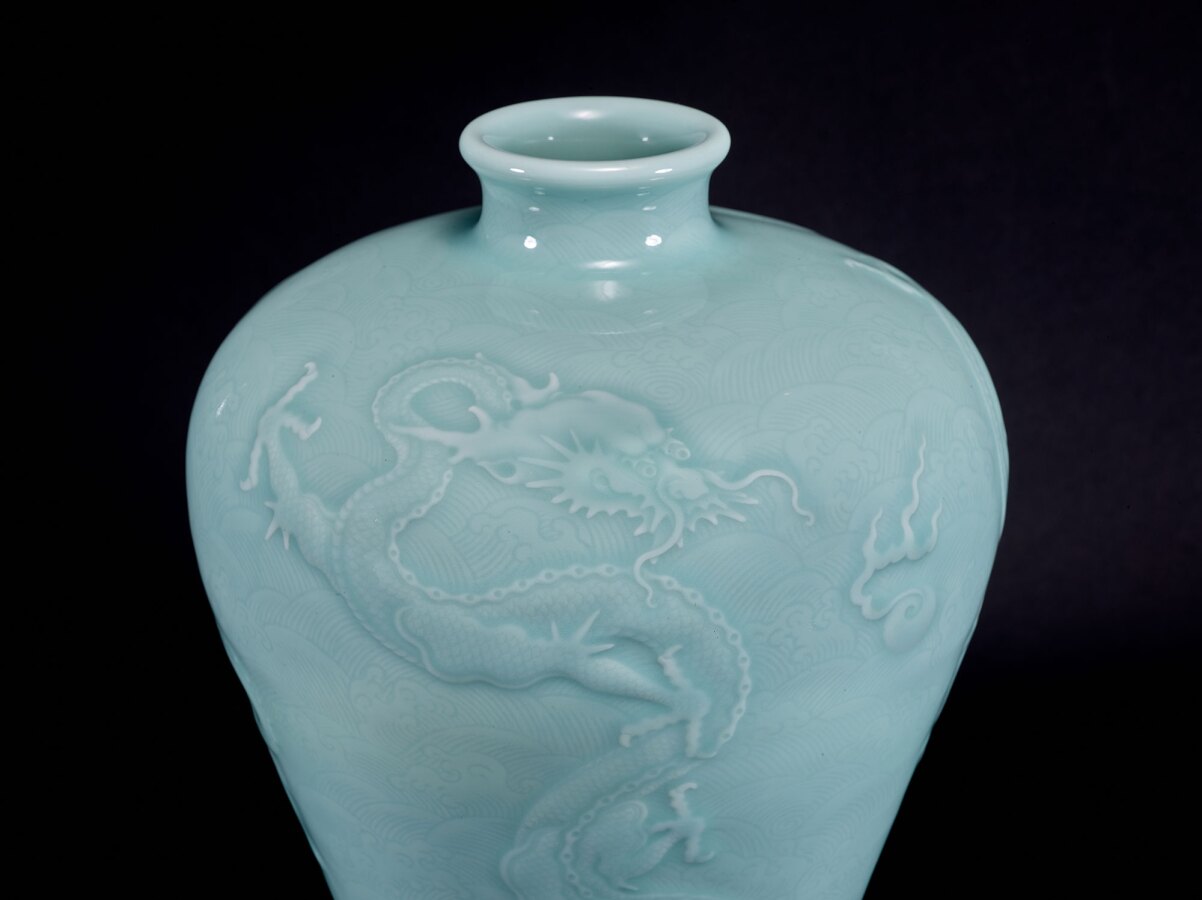
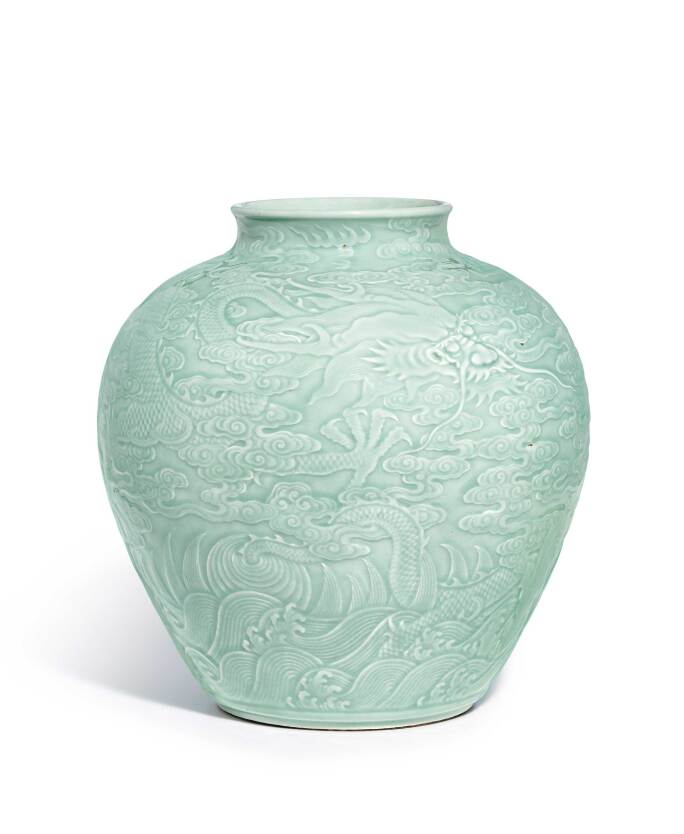
Carved celadon-glazed 'dragon' jar, seal mark and period of Qianlong
Sotheby's Hong Kong, 8th October 2014, lot 3901
The portrayal of dragons with differing numbers of claws can also be found on other contemporaneous porcelains, particularly meiping rendered with nine dragons, including a cobalt-blue and copper-red example with a related design from the Qianlong period, sold once in our London rooms, 27th November 1973, lot 275, and three times in these rooms, 22nd May 1979, lot 197, 7th May 2002, lot 579, and 10th April 2006, lot 1536 (fig. 3); and a Qianlong seal mark and period cobalt-blue and iron-red example in the collection of the Palace Museum, Beijing, illustrated in Kangxi. Yongzheng. Qianlong. Qing Porcelain from the Palace Museum Collection, Hong Kong, 1989, pl. 8.
This pristine vase, with its almost tercentenary brilliance and lustre preserved, is possibly unique; no closely related example of the design and size appears to be recorded. Compare a very similar but slightly smaller example (34.9 cm), also decorated with five dragons but arranged differently from the current one – regrettably bearing a firing crack extending across the mark and along one side of the vase – sold in our New York rooms, 4th June 1982, lot 220; and a further smaller example (33 cm), of less dramatic form and carved with three five-clawed dragons, first sold in our New York rooms, 4th June 1982, lot 219, from the collection of Albert Keller, and later sold at Christie’s Hong Kong, 3rd November 1996, lot 572, from the Jingguangtang collection. See also a Qianlong seal mark and period celadon-glazed jar, densely carved with two large five-clawed dragons in relief, endowed with an illustrious provenance, having once belonged to the Lord Loch of Drylaw and the collection of the Idemitsu Museum, Tokyo, sold in these rooms, 8th October 2014, lot 3901 (fig. 4).
“Only by the form, the pattern, can words or music reach the stillness, as a Chinese jar still moves perpetually in its stillness.”
Perhaps it would not be so preposterous to extend Eliot’s analogy to this imposing meiping. Not only is it masterfully depicted with a dynamic scene of ferocious dragons soaring amidst tempestuous waves, it has also stood sturdily as a material movement across centuries through and through.
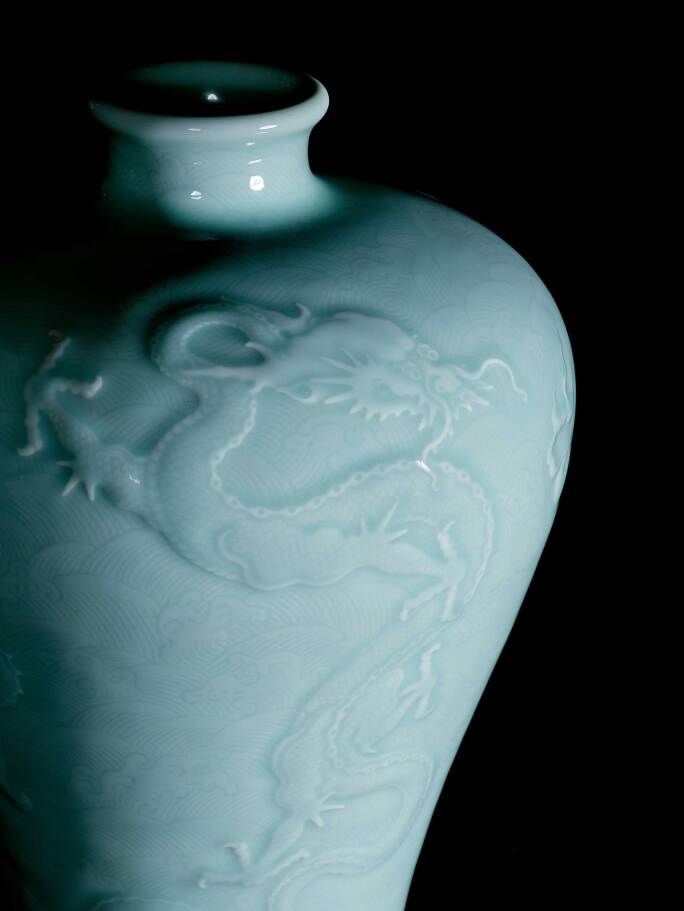
Lot 6008 - Details

A Fine, Superb and Possibly Unique Carved Celadon-Glazed 'Dragon' Vase, Meiping
Seal Mark and Period of Qianlong
masterfully potted of generous proportions with sides steeply rising from a gently splayed foot to broad prominent shoulders and surmounted by a constricted neck and lipped rim, the exterior of the vessel exceptionally and crisply carved in relief with a continuous scene depicting five scaly dragons soaring sinuously amidst cresting and foaming tumultuous waves, the largest beast rendered three-clawed and swooping down from the shoulder with a flaming pearl in its mouth, above a smaller five-clawed dragon emerging from the waves below, a further three-clawed dragon portrayed sinuous and extending vertically along one side of the vessel in pursuit of a flaming pearl, a fourth dragon depicted en face and writhing above a fifth beast with its claws outstretched towards a flaming pearl and rendered partially concealed by the crashing waves below, all against a ground of waves incised over sides of the vase below the lipped rim, veiled overall save for the unglazed footring with a lustrous and translucent bluish-green glaze, the countersunk base centred with a six-character seal mark in underglaze blue
35.3 cm, 13 7/8 in.
PROVENANCE
An English collection.
Sotheby's Hong Kong, 4th/5th November 1997, lot 1356.
LITERATURE
Sotheby's Thirty Years in Hong Kong: 1973-2003, Hong Kong, 2003, pl. 150.

